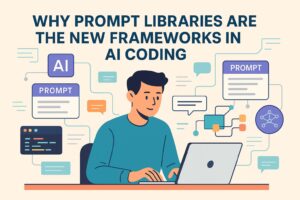🧠 Introduction: Prompt Engineering Has Leveled Up
In 2023 and 2024, prompt engineering emerged as an unexpected but vital part of building anything with AI — from chatbots to agents to copilots. But in 2025, we’ve entered a new era: prompts are no longer just clever text hacks. They’re structured, versioned, shared, and maintained just like code.
Enter prompt libraries — the new frameworks for AI development.
Whether you’re building with LangChain, PromptLayer, or custom APIs, prompt libraries now provide a standardized, reusable approach to building AI functionality. In this guide, we’ll explore why this shift matters, what prompt libraries look like, and how to integrate them into your own projects.
🔍 What Are Prompt Libraries?
A prompt library is a collection of well-crafted, reusable prompts organized like a codebase. It’s designed to:
- Enable consistent behavior across AI features
- Handle variations in tone, structure, or task
- Abstract prompt logic away from business logic
- Allow for version control, testing, and reuse
💡 Think of it like this:
Just as a front-end framework gives structure to your UI, a prompt library gives structure to your AI logic.
Prompt libraries can be:
- JSON/YAML files of prompt templates
- Markdown-based documentation sets
- LangChain chains or tools
- Packages that expose prompts via API or SDK
- Self-hosted repositories with reusable prompt modules
🧱 Why Prompts Are Becoming Like Frameworks
In 2025, the way developers think about prompts has changed.
1. Reusability is Key
Developers don’t want to reinvent the wheel every time they need a summarizer or email generator. Prompt libraries save time and enforce consistency across AI features.
2. Prompt Logic Is Now Business Logic
As AI features drive products, prompts become core to the product itself — they affect UX, output accuracy, tone, and functionality.
3. Testing and Versioning Are Now Essential
Prompt libraries can be tested (yes, with AI!) for regressions. You can version them just like any software component.
4. Multi-model Compatibility
Prompt libraries now support multiple LLMs — GPT-4o, Claude 3, Gemini, Mistral, etc. Abstracting prompts into libraries makes it easier to switch models or fine-tune behavior across them.
🧰 Popular Prompt Libraries & Tools in 2025
Here are the leading tools that treat prompts as serious development assets:
✅ LangChain PromptTemplates
Structure and store prompts for any chain. Enables parameterization, memory, history injection, and more.
✅ PromptLayer
Track, version, and compare prompt outputs over time. Offers dashboards for observability and team collaboration.
✅ PromptHub (by Humanloop)
A GitHub-style platform for finding, testing, and integrating high-quality prompts across industries.
✅ LlamaIndex Prompts
Used in RAG (Retrieval-Augmented Generation) pipelines. Offers modularity and prompt injection for smart context handling.
✅ Your Own Prompt SDK
Many devs now build their own internal prompt libraries wrapped in APIs, functions, or reusable hooks/components.
💻 Real Use Cases Where Prompt Libraries Shine
| Use Case | Why Prompt Libraries Help |
|---|---|
| AI Chatbots | Maintain tone/personality across flows |
| Code Generators | Abstract language-specific formatting prompts |
| AI Docs / Summarizers | Consistent summarization style |
| Agents | Prompt-based logic branching |
| Marketing Tools | A/B test variants from one source of truth |
🔨 How to Build Your Own Prompt Library
Want to start small? Here’s a basic stack to build your own:
- Create a prompts folder in your repo
- Use
prompt_name.mdor.jsonfiles with placeholders like{user_input}
- Use
- Add PromptLoader function
- In JS/TS or Python, dynamically fetch and inject variables
- Wrap them in API-ready functions
generateProductDescription(input)reads fromdescription-prompt.md
- Track outputs using tools like PromptLayer or LangSmith
- Version your prompts in Git just like code
Pro Tip: Add comments or YAML frontmatter in each prompt file for documentation, owners, and version tags.
🚀 The Future of Prompt Libraries: Frameworks for AI Logic
Here’s where we’re heading:
- ✅ Prompt validation & static analysis
- ✅ Prompt unit tests (yes, really)
- ✅ Prompt IDEs (VS Code extensions already exist!)
- ✅ Shared prompt marketplaces
- ✅ Team collaboration tools for prompt management
Soon, AI products will treat prompts like APIs — with documentation, endpoints, testing, and changelogs. We’re already seeing startups building “prompt devops” pipelines.
Frequently Asked Questions
Q1. Are prompt libraries only useful for large projects?
No. Even small projects benefit from reusing consistent prompts and abstracting them for flexibility.
Q2. How do I test prompts?
Use tools like PromptLayer, LangSmith, or write your own scripts that simulate expected output for various inputs.
Q3. Can I use prompt libraries with open-source models?
Absolutely. Whether you’re using Ollama, LocalAI, or Mistral, you can structure your prompts for any LLM interface.
Q4. Do I need to learn LangChain to use prompt libraries?
Not at all — but LangChain does make it easier if you’re building more complex chains or agent flows.
🔗 Related Posts You’ll Love
- How Prompt Engineering Is Redefining AI Model Performance in 2025
- Top 10 AI Coding Assistants You Can Use for Free
- Cursor AI vs. GitHub Copilot: Which AI Coding Assistant is Right for You?
📌 Conclusion: Frameworks of the AI Era
If 2024 was the year of “prompt hacking,” then 2025 is the year of prompt architecture. Prompt libraries are becoming essential for building reliable, scalable, multi-model AI features — and forward-thinking developers are already building their stacks around them.
Start treating your prompts like code — and your future AI tools will thank you.





